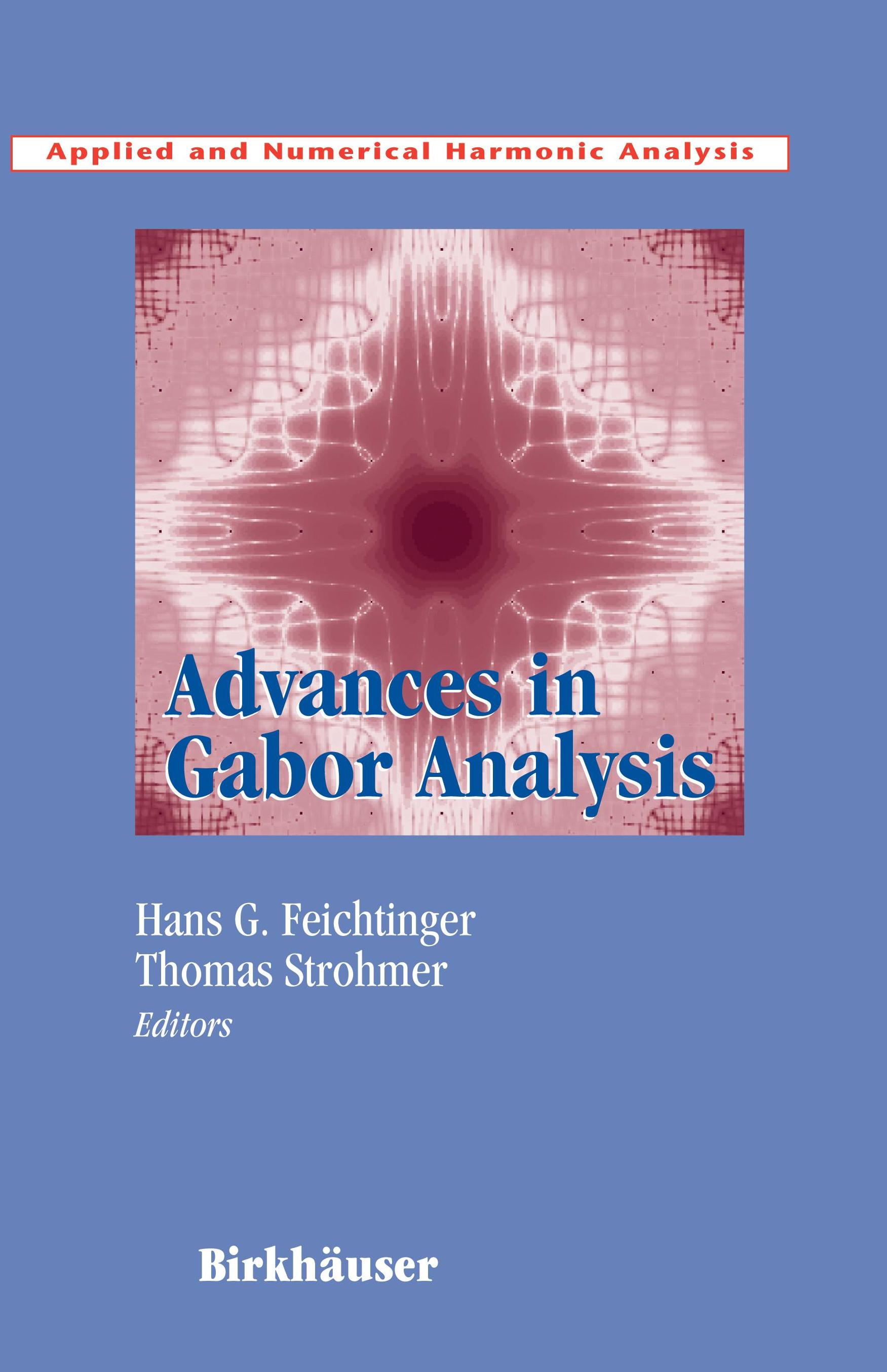
Advances in Gabor Analysis
H.G. Feichtinger, University of Vienna (Ed.)
T. Strohmer, University of California at Davis (Ed.)
Birkhäuser 2002 * Hardcover * 368 pages * 22 Illustrations
Series: Applied and Numerical Harmonic Analysis
This unified, self-contained volume provides insight into the richness of Gabor analysis and its potential for future development in applied mathematics and engineering. Mathematicians and engineers treat a range of topics covering theory as well as applications in eleven survey chapters. Taken as a whole, the work demonstrates interactions and connections among different areas in which Gabor analysis plays a critical role, including harmonic analysis, operator theory, quantum physics, numerical analysis, electrical engineering, and signal/image processing.
Key features of the work:
- Gives an overview of recent developments in Gabor analysis, an important tool in the understanding and use of time-frequency analysis methods in a variety of disciplines
- Provides sufficient background material along with many new and previously unpublished results
- Presents applications to areas such as digital and wireless communications
- Up-to-date bibliographies for each chapter; useful subject index for the entire volume
- Specific topics covered include: Uncertainty Principles for Time-Frequency Representations; Zak Transforms; Bracket Products for Weyl?Heisenberg Frames; Gabor Multipliers; Gabor Analysis and Operator Algebras; Integral Operators, Pseudodifferential Operators and Gabor Frames; Methods for Approximation of the Inverse (Gabor) Frame Operator; Wilson Bases
Graduate students, professionals, and researchers in pure and applied mathematics, mathematical physics, electrical and communications engineering will find Advances in Gabor Analysis a comprehensive resource.
Contents:
Foreword / Henry Landau
Contributors
- 1. Introduction / H.G. Feichtinger & T. Strohmer
- 1.1 Recent trends in Gabor Analysis
- 1.2 Outline of the book
- 2. Uncertainty Principles for Time-Frequency Representations / K.Gröchenig
- 2.1 Introduction
- 2.2 The Classical Uncertainty Principle
- 2.3 Time-Frequency Representations
- 2.4 Support Conditions
- 2.5 Essential Support Conditions
- 2.6 Hardy's Uncertainty Principle
- 2.7 Beurling's Theorem
- References
- 3. Zak Transforms with Few Zeros and the Tie / A.J.E.M. Janssen
- 3.1 Introduction and Announcements of Results
- 3.2 Zak Transforms with Few Zeros
- 3.3 When is $(\chi _{[0,c_0)},a,b)$ a Gabor Frame?
- References
- 4. Bracket Products for Weyl-Heisenberg Frames / P. Casazza & M.C. Lammers
- 4.1 Introduction
- 4.2 Preliminaries
- 4.3 Pointwise Inner Products
- 4.4 $a$-Orthogonality
- 4.5 $a$-Factorable Operators
- 4.6 Weyl--Heisenberg Frames and the $a$-Inner Product
- References
- 5. A First Survey of Gabor Multipliers / H.G. Feichtinger & K. Nowak
- 5.1 Introduction
- 5.2 Notation and Conventions
- 5.3 Basic Theory of Gabor Multipliers
- 5.4 From Upper Symbol to Operator Ideal
- 5.5 Eigenvalue Behavior of Gabor Multipliers
- 5.6 Changing the Ingredients
- 5.7 From Gabor Multipliers to their Upper Symbol
- 5.8 Best Approximation by Gabor Multipliers
- 5.9 STFT-multipliers and Gabor Multipliers
- 5.10 Compactness in Function Spaces
- 5.11 Gabor Multipliers and Time-Varying Filters
- References
- 6. Aspects of Gabor Analysis and Operator Algebra / J.P. Gabardo & D. Han
- 6.1 Introduction
- 6.2 Background
- 6.3 The Density (or Incompleteness) Property
- 6.4 Characterizing the Unique Gabor Dual Property
- 6.5 Gabor Frames for Subspaces
- References
- 7. Integral Operators, Pseudodifferential Operators and Gabor Frames / C. Heil
- 7.1 Introduction
- 7.2 Discussion and Statement of Results
- 7.3 The Modulation Spaces
- 7.4 Invariance Properties of the Modulation Space
- 7.5 Gabor Frames
- 7.6 An Easy Trace-Class Result
- 7.7 Finite-Rank Approximations
- 7.8 Improving the Estimate
- 7.9 Conclusion and Observations
- References
- 8. Approximation of the Inverse (Gabor) Frame Operator / O. Christensen, T. Strohmer
- 8.1 Introduction
- 8.2 The Double Projection Method
- 8.3 Projection Methods for Gabor Frames
- 8.4 On Sampling of Gabor Frames in ${{\boldsymbol L}^2({\@mathbb R})}$
- References
- 9. Folding Operators, Wilson Bases, and Zak Transforms / K. Bittner
- 9.1 Introduction
- 9.2 Wilson Bases of $L^2(\@mathbb {R})$
- 9.3 Wilson Bases for Periodic Functions
- 9.4 Wilson Bases on the Interval
- 9.5 Algorithms
- References
- 10. Localization Properties and Wavelet-Like Orthonormal Bases for the Lowest Landau Level / J.P. Antoine & F. Bagarello
- 10.1 Introduction: Phase Space Localization
- 10.2 The Fractional Quantum Hall Effect
- 10.3 A Toy Model
- 10.4 Wavelet Bases for the LLL
- 10.5 Magnetic Translations and Multiresolution Analysis
- 10.6 Conclusion
- 10.7 Appendix: Two Mathematical Tools
- References
- 11. Optimal Stochastic Approximations and Encoding Schemes Using Weyl-Heisenberg Sets / R. Balan & I. Daubechies
- 11.1 Introduction
- 11.2 Stochastic Processes and Statement of the Problems
- 11.3 Semi-optimal and Optimal Solutions
- 11.4 Non-Localization Results
- 11.5 Numerical Examples
- 11.6 Conclusions
- References
- 12. Orthogonal Frequency Division Multiplexing Based on Offset-QAM / H. Bölcskei
- 12.1 Introduction and Outline
- 12.2 Orthogonal Frequency Division Multiplexing Based on OQAM
- 12.3 Orthogonality Conditions for OFDM/OQAM Pulse Shaping Filters
- 12.4 Design of OFDM/OQAM Filters
- 12.5 Biorthogonal Frequency Division Multiplexing Based on Offset QAM
- 12.6 Conclusion
- 12.7 Appendix
- References
Index